We were recently on an island in the Caribbean which has achieved notoriety for the notable disappearance of several young ladies. We are pleased to say that we returned after one week of sun, surf, warm weather and cobalt blue water. It was almost like a real life "ground hog day" experience. Every day much the same as the previous day--same weather, same cobalt blue sea, same fellow in white shorts and tennies greeting us to place our same 4 allotted towels under our allotted palapas (grass huts that provide shade). Having said that, there is no doubt that the beaches are spectacular.
Monday, May 14, 2012
Sunset at the restaurant on the beach
Friday, May 11, 2012
Garlic chive omelet ニラ玉
Japanese really like garic chives or nira ニラ. I see garlic chives rarely in the regular grocery store but, fortunately, we have garlic chives growing in our herb garden and they just emerged for spring. When I told our Japanese landscaper that our garlic chives tend to be tough, he told me to cut them off frequently even if you do not eat what you cut. That way, new teder shoots will keep coming up. So, I am harvesting occasionally even if I do not use it.

As long as you have fresh garlic chives, this is an easy dish. There appears to be two basic styles; for one the eggs just get scrambled with the garlic chives and in the other is to mix the chives and eggs to make a round omelet. The difference may seem subtle but the end result is different in consistency--the round one is almost like a Spanish tortilla. I chose the latter and also made a sauce or "an" 餡.
Japanese think the combination of garlic chives and eggs is particularly good. This dish, "Nira-tama", "nira" means garlic chives and "tama" is short for "tamago" meaning eggs, is one of these dishes and must have a root in a chinese dish.
Fresh garlic chives (one small bunch) chopped into small pieces. I mixed the pieces into the beaten eggs (2 large) and seasoned with salt and pepper (left). In a small no-stick frying pan, I added vegetable oil and sesame oil (1:1 total of about 3 tsp) and cooked it on medum low flame for a few minutes and flipped over (right)
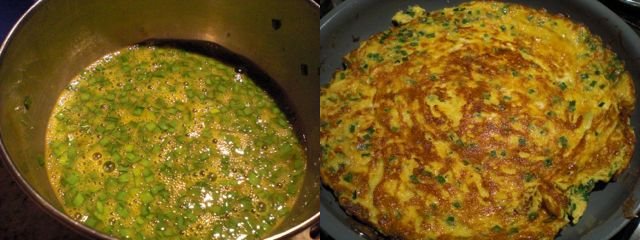
For the sauce, I simply mixed dashi (1/4 cup), soy sauce (1 tbs) and mirin (1 tbs). When it came to a boil, I added a potato starch slurry made with sake (2 tsp) to thicken the sauce. You could add vinegar to make it a sweet and sour sauce or add hot sauce to make it spicy.
I served this as a drinkng snack. This late spring/early summer garlic chives were tender but did not have a strong flavor--it was a classic taste of the season. I served this with asazuke of cucumber, daikon and carrot, blanched broccolini with mustard soy sauce dressing or "Karashi souyu" 芥子醤油.
I served this as a drinkng snack. This late spring/early summer garlic chives were tender but did not have a strong flavor--it was a classic taste of the season. I served this with asazuke of cucumber, daikon and carrot, blanched broccolini with mustard soy sauce dressing or "Karashi souyu" 芥子醤油.
Wednesday, May 9, 2012
Pan fried shad roe with bacon シャド 魚卵のベーコン焼き
My understanding is that shad is type of fish which lives in the ocean (Atlantic in the U.S.) but swims up the river to spawn in spring. I do not think a similar fish exists in Japan. The roe of this fish is more valuable than the fish itself. It is also very seasonal and only appears in fish markets, in March and April. The first time I saw shad roe, I was a bit surprised to learn that Americans eat "fish eggs". As I mentioned before, when I made shrimp roe with scrambled eggs, the classic way to cook shad roe is scrambled with hen's eggs as a breakfast, which was also surprising to me since "fish" or "fishy" food are usually not eaten for breakfast in the U.S.. I mentioned in passing, when I posted simmered cod roe "Tarako", that I could make a similar dish with shad roe.
Speaking of seasonal food or shun 旬 (which is mostly lost since almost everything is available year around), it also applies to "soft shell crab" season. So one evening, on the way home from work, we stopped at the near-by gourmet grocery store and got live (until it was cleaned) soft shell crabs (which was consumed as "tempura" immediately that evening) and shad roe (which was prepared for the next evening and is the subject of this post).

I asked my wife how she likes shad roe to be prepared. She was not keen on the idea of simmering it in the broth in a Japanese style. She told me of how her grandparents looked forward to shad roe season and brought them home with much fan fare mostly to be served with eggs at breakfast but also in the traditional way with bacon. She mentioned that aside from caviar, shad roe were the only fish eggs she had ever eaten before she met me. So in honor of her nostalgia, I cooked these roe American style as you see in the picture above. Shad roe is similar to tarako or cod roe but the eggs are a bit coarser. I panfried it in browned butter and bacon fat and finished it in an oven. As a side I made sautéed shimeji mushrooms and baby spinatch using the remaining bacon fat and butter.

Cooking: I first slowly cooked one strip of bacon in a frying pan (for 7-10 minutes) until the bacon fat was rendered and the bacon became crispy. I set aside the bacon and added a pat of butter (1/2 tbs) and turned up the flame to medium. When the butter melted and started browning, I put the shad roe in and cooked for 2 minutes.Then carefully turned them over (the roe was still soft) and cooked it for another minutes or so until the surface get brown and crispy (another 2-3 minutes). I finished cooking in a 350F oven for 5 minutes. It is important not to over cook. I was aiming for, when pressed, soft but somewhat elastic texture (I read somewhere that this was described as "like a ripe avocado").
For the sides, after I removed the roe and set it aside, I put, in the same frying pan on medium flame, the mushrooms and sautéed them for several minutes seasoned with salt and pepper. I pushed the mushrooms aside and sautéed baby spinach next until wilted (less than 1 minute), again, seasoned with salt and pepper.
Shad roe: I removed the membrane connecting two roe sacks first and then soaked them in cold salted water (taste just salty, 3%??) in a sealable container which can hold the roe sacks comfortably in a refrigerator for over night. You could skip this step but since we were having soft shell crabs that evening, this was a perfect step for us. It removes some of the fishy taste/smell and also brines or seasons it. Next day, I removed them from the salt water and patted them dry using paper towels. I then seasoned them with salt and pepper (left in the picture below). I then dredged with flour.
For the sides, after I removed the roe and set it aside, I put, in the same frying pan on medium flame, the mushrooms and sautéed them for several minutes seasoned with salt and pepper. I pushed the mushrooms aside and sautéed baby spinach next until wilted (less than 1 minute), again, seasoned with salt and pepper.
I sliced the shad roe and garnished with crispy bacon bits and chopped parsley and served with wedges of lemon. I think that any Japanese would like this dish and it will sell in Izakaya. The shad roe has a just slightly fishy taste with a nice consistency (like that of a meatball) and browned butter and bacon fat combination cannot go wrong.
Monday, May 7, 2012
Honey mead 1992 vintage ミード蜂蜜酒1992
Many years ago, I was into making beer (ale, to be exact). My wife was not particularly fond of beer, although she said, my beer was best she ever tasted. Since I had all the brewing apparati (fermentation buckets, air locks, tubings, glass carboys etc), I made mead for a few years (1992 - 95) by her request. Since it tastes better if we give a chance to "mature" we tucked it away and promptly forgot about it. Recently, we were cleaning out the storage area and came upon all the boxes filled with bottles of mead quietly sitting in the dust. Since my first attempt at making mead was vintage 1992 and if it were a kid would be going to college we thought it was time to pop the cork.
Mead must be one of the earliest alcoholic beverages human had on hand. Essentially honey water fermented, which could happen naturally. Although the name "Honey mead" sounds like a sweet beverage, in its original form, it is totally dry since all the sugar is converted to alcohol. Some of the commercial meads are sweet because of the addition of honey or sugar after fermentation.
One of the problems with brewing is contamination which can give rise to off-tastes. Keeping sanitary conditions is very important when fermenting anything, either wine, beer or mead. My understanding is that, in the old days, because off-tastes often developed in mead due to contamination, honey was added to cover up the bad taste which gave rise to "sweet" mead. Mine was done under strict sanitary conditions and is bone dry.
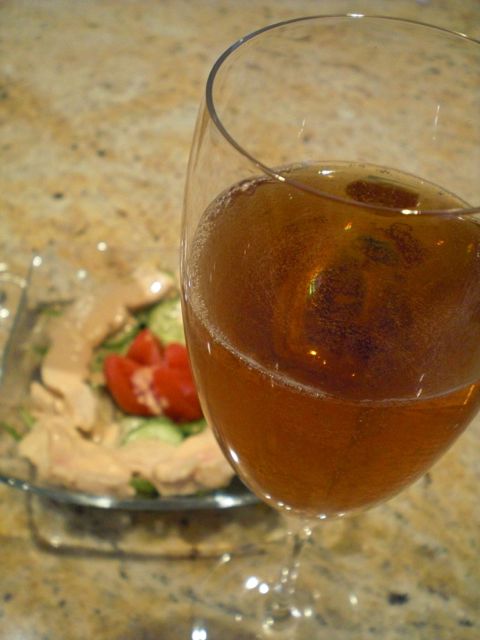
This was a sparkling mead with hops. Apparently, I had easy access to freeze dried quality hops at that time. I do not remember the exact recipe but I must have used a fragrant finishing hop and Champagne yeast which can ferment to a higher alcohol level than ale or wine yeast. After 20 years of bottle aging (I used a beer bottle which was capped with a crown), the bubbles were rather weak but the color was nice dark brown as you can see above.
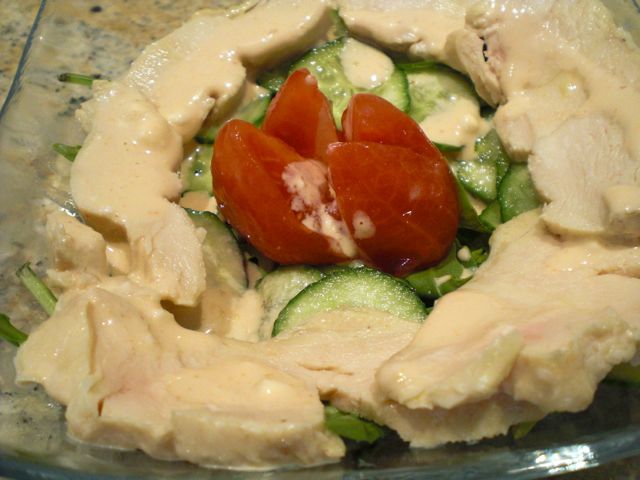
I was amazed that my mead survived for 20 years in our basement (we actually have quite a supply including some bottled in champagne bottles--I must have been quite industrious at one point). I have another batch flavored with raspberries (from 1995, I think) which we should try next. Only problem is, once we drink this supply It will be another 20 year wait for the next batch.
It is dry but the aromatic flavors of the honey was still there. Hops were added because of the taste and as a preservative but at this point, only a very subtle bitterness (which is quite refreshing) remains.
I concocted a quick chicken salad to go with the mead. The chicken was sliced microwave sake-steamed chicken breast. I placed it on a bed of baby arugula with sliced mini-cucumber (salted and extra moisture rung out), a skinned and quartered Campari tomato. The dressing was a mixture of mayonnaise and plain yogurt seasoned with hot sauce (Sriracha) and soy sauce. The proportion of mayo and yogurt is abut 1:1 (2 tbs each), hot sauce (1/2 tsp but this is totally up to your taste) and soy sauce (1/2 tsp). I diluted the mixture with the addition of juice from the chicken container (protein from chicken, salt, sake with flavor of ginger and scallion) but you could just use water to loosen the dressing or you do not have to make it loose. I drizzled the dressing over the salad.
The salad was pretty good. The heat from the hot sauce came on slowly but it is quite pleasant and went well with our mead.
Saturday, May 5, 2012
Sea Urchin pasta with poached egg 雲丹のパスタ温泉卵のせ
When we got sashimi from Catalina, only "premium" uni was available. After three days, one tray was left. Since the premium uni was a bit soft to begin with and the edges were disintegrating a bit (tasted OK, though), I decided to make another version of Uni pasta. I suggested to my wife, Carbonara style or a poached egg on the top. She chose the latter.

There is nothing different from what I posted before except for placing a poached egg on the top. As before, I used angel hair pasta. I added olive oil (or butter) in the frying pan (1 tbs) and added the cooked pasta and cream (3-4 tbs) and heated it up. When the cream was slightly reduced and coated the pasta, I put the uni in the pan (leaving a few aside for garnish) and mixed them with the pasta using a silicon spatula. Then I cut the flame. I tasted it and seasoned it with a bit of salt and pepper and also mixed in finely chopped parsley (Perilla or chives would also have been fine but I did not have them).
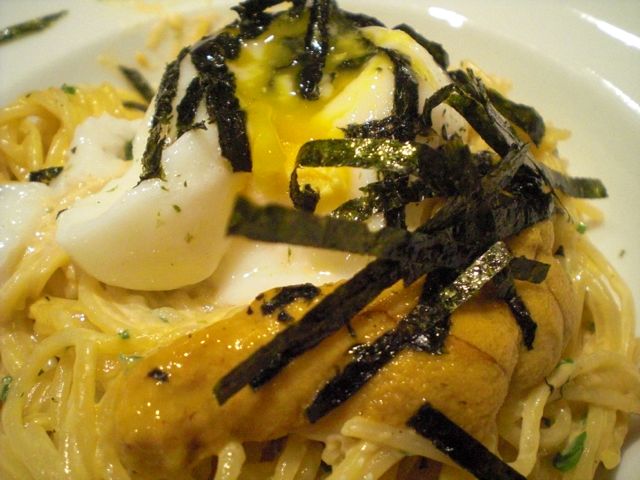
The combination of cream, uni, and egg yolk made this dish ultra rich and creamy. Although I was a bit disappointed with the quality of the sashimi items we received from Catalina this time, this was a quite piece de resistance to finish up the uni.
Porched eggs were made in our usual way with the yolk still runny (using pasteurized shell eggs). I garnished with thin strips of nori.
Thursday, May 3, 2012
Yaktori-style grilling 焼き鳥風グリル
For one reason or another, we have not had a chance to grill outside in Yakitori-style for a long time. Since it was warm, mosquitos were not out (yet), and we regained access to our Yakitori grill, we decided to do an impromptu Yakitori-style grill. Since we did not have much time for preparation, I made a simple grill including;
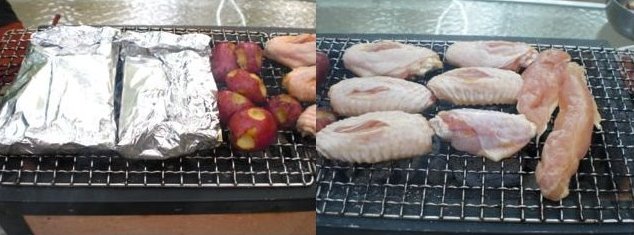
The shimeji was very good with miso and butter flavors (below). As I mentioned before, a similar dish made of enoki mushroom was the dish we enjoyed at the Robatayaki restaurant in San Francisco Japan town in our earlier days.
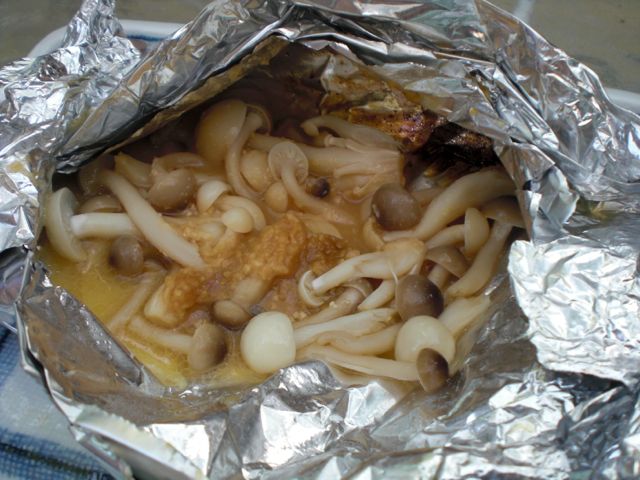
My wife was mashing up the grilled potatoes in this sauce (She even raided my packet since I had some sauce left). The royal trumpet mushroom had a nice firm meaty texture. The chicken parts were all good as expected, although the surface was a bit charred due to the sugar content of the marinade. After finishing the chicken and the vegetables, I also started grilling our perfect grilled rice balls as you can see in the first picture below.
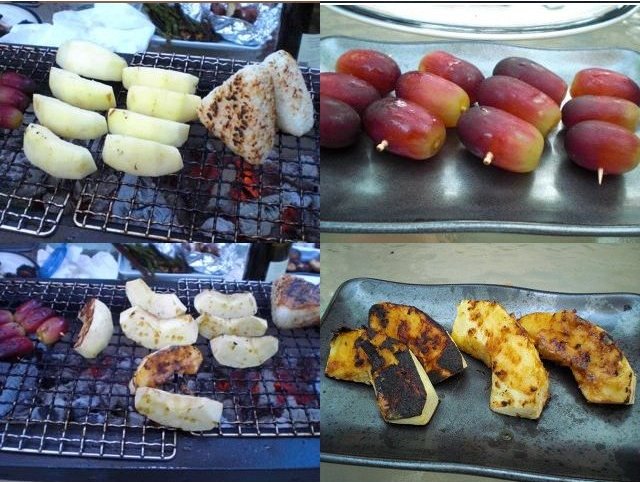
My wife disappeared and brought down some sliced Fuji apples and red seedless grapes on skewers. She suggested I grill them as a dessert (see the picture above). She also suggested that I smear the miso sauce I had used for the chicken tenders and the rice balls on the apples. I have heard of grilling peaches and pineapples but no apples and grapes. (Leave it to my wife to come up with out-of-the-box (grill??) ideas).
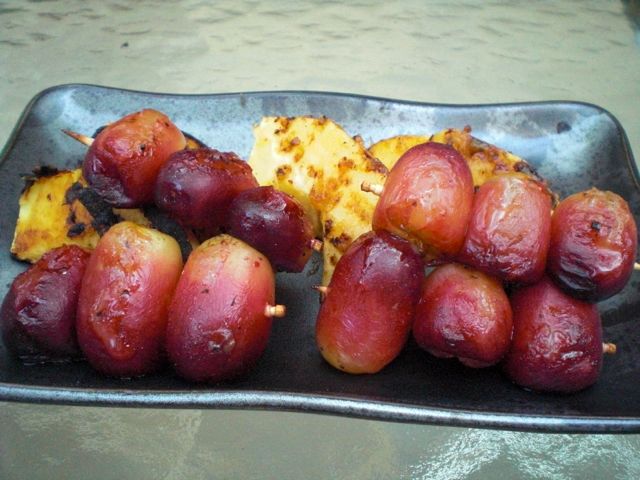
This picture shows a plate of our dessert. The apples were still firm and juicy inside but the surface was caramelized and sweet. The miso added a nutty and slighly salty flavor that was unusual but quite nice. The grilled grapes were new to me. I fully expected them to explode when they were over the fire, but they didn't. Again, the surface got slightly caramelized and the sweetness was enhanced. They went extremely well with the red wine we were drinking. We, as always, enjoyed eating al fresco.
1. Chicken wings and drumetts (marinated in sake, mirin, salt, and Sriracha hot sauce for several hours but I should have just grilled with salt and pepper)
2. Chicken tenders (marinated in sake and salt. After it was almost cooked, I smeared miso sauce - mixture of miso and mirin - and finished cooking).
3. Vegetable: small red potatoes (microwaved and then cut in half, coated with olive oil and salted), Royal trumpet mushrooms (torn lengthwise into 2 to 4 pieces depending on the size and seasoned with soy sauce, sake, mirin and coated with olive oil), and asparagus (coated with olive oil and seasoned with salt and black pepper). We also had shimeji mushrooms in a packet (a pat of butter, miso disolved in sake and mirin with an addition of sugar).
Here, from the left are two shimeji packets, red potatoes, wings, and tender.
Here, from the left are two shimeji packets, red potatoes, wings, and tender.
Tuesday, May 1, 2012
Chicken teriyaki 鶏腿肉の照り焼き
"Teriyaki" 照り焼き was popularized in the U.S. early on as a Japanese dish, probably in the same period "Sukiyaki" was getting popular. It has been incorporated in American home cooking (especially backyard BBQ) and you can buy a bottle of "Teriyaki" sauce (from Kikkoman and others) in any grocery store. I am not sure American-style "Teriyaki" even qualifies as an authentic Japanese dish. Usually, the teriyaki sauce is used as marinade and/or like a BBW sauce for meat. The meat is then grilled.
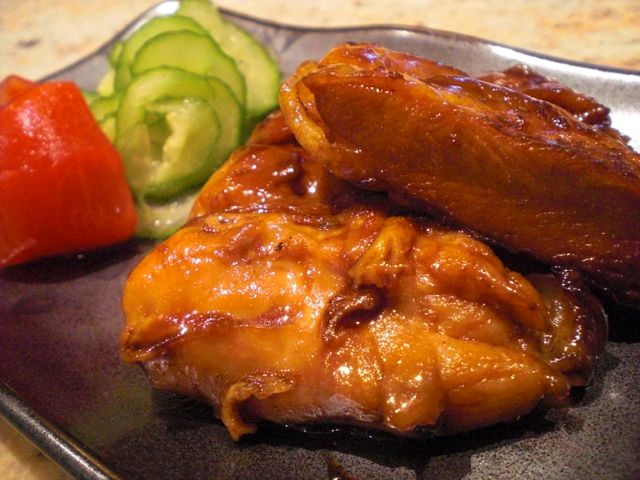
If I am making teriyaki chicken from scratch, I prefer to use thigh meat, deboned but skin on. I butterfly the thickness part to make the entire piece even thickness. I could marinate (mirin and soy sauce or sake and salt) but that is optional. I cook it from the skin side first in a frying pan until the skin is well browned (removing some excess oil by blotting with a paper towel) and cook the other side. In this occasion, I used leftover thigh meat which was salted and grilled (two thighs, that had been grilled in a George Forman's grill) so I skipped this process. Since the chicken was already cooked I went directly to the "saucing" step.
Since this was made from leftover grilled salted chicken, it took less than 5 minutes to make. This was a sort of cannot-go-wrong type of small dish if not exciting. The cinnamon flavor of the Chinese 5 spices came out rather prominently. If you do not like this, stick to "Sansho" powder.
The original Japanese cooking technique of "Teriyaki" is braising not really grilling. "Teri" 照り means glossy surface or luster and "Yaki" 焼き means grilled but "Yaki" in Japanese could mean braised as in "Sukiyaki". So, any dish braised in a sauce (usually soy sauce based with sugar) until the sauce is reduced and thick (due to the sugar content) and coats the surface of the food items is called "Teriyaki" either meat or fish.
I then poured in "Teriyaki sauce"* and put the lid on for a few minutes (in this case, I really did not need to cook the chicken further). With the lid off, I turn up the flame and reduced the sauce until it became thick; clinging to the surface of the chicken giving "teri" or luster to the surface. Just to be slightly different, I sprinkled Chinese 5 spices (or Japanese "sansho" 山椒powder) to finish.
*You could use a bottled one but I just use a mixture of soy sauce and mirin (about 1:1).
Since this was made from leftover grilled salted chicken, it took less than 5 minutes to make. This was a sort of cannot-go-wrong type of small dish if not exciting. The cinnamon flavor of the Chinese 5 spices came out rather prominently. If you do not like this, stick to "Sansho" powder.
Subscribe to:
Comments (Atom)


